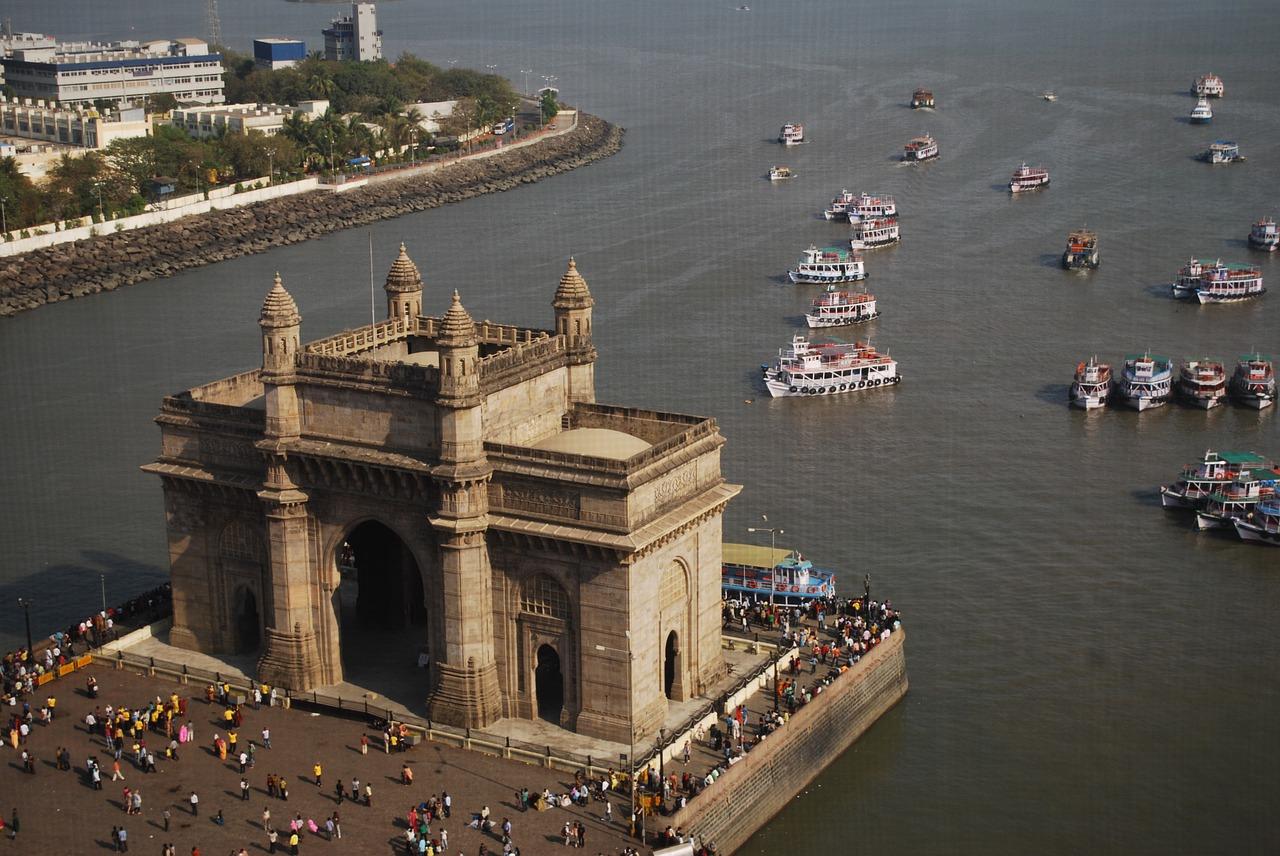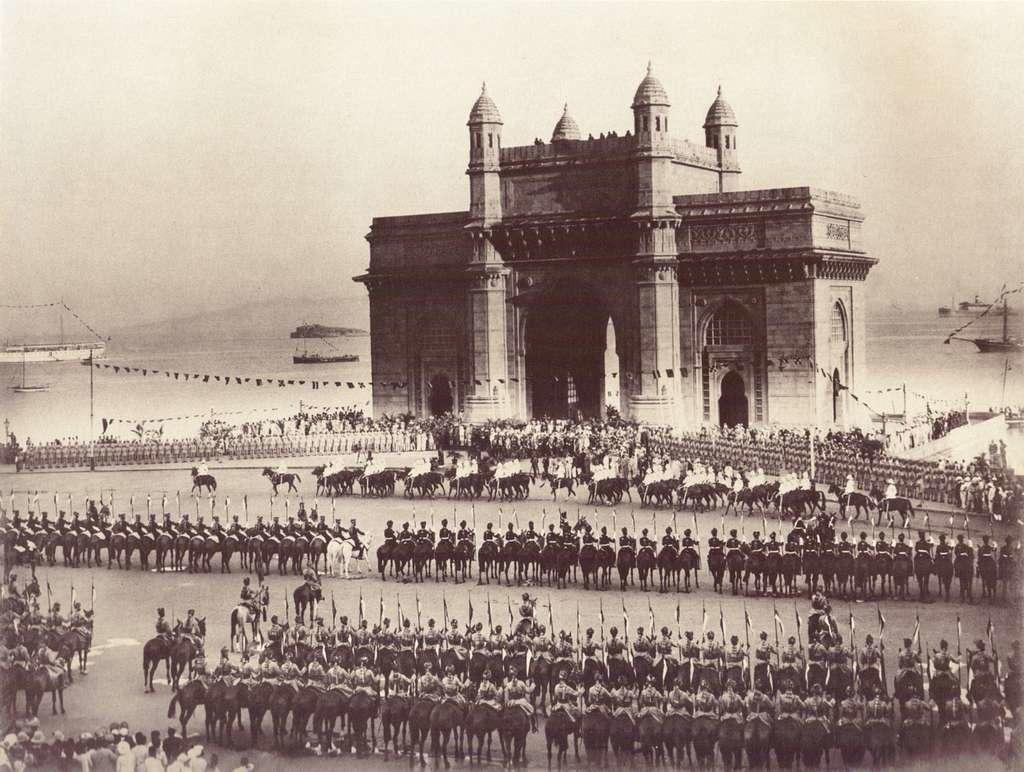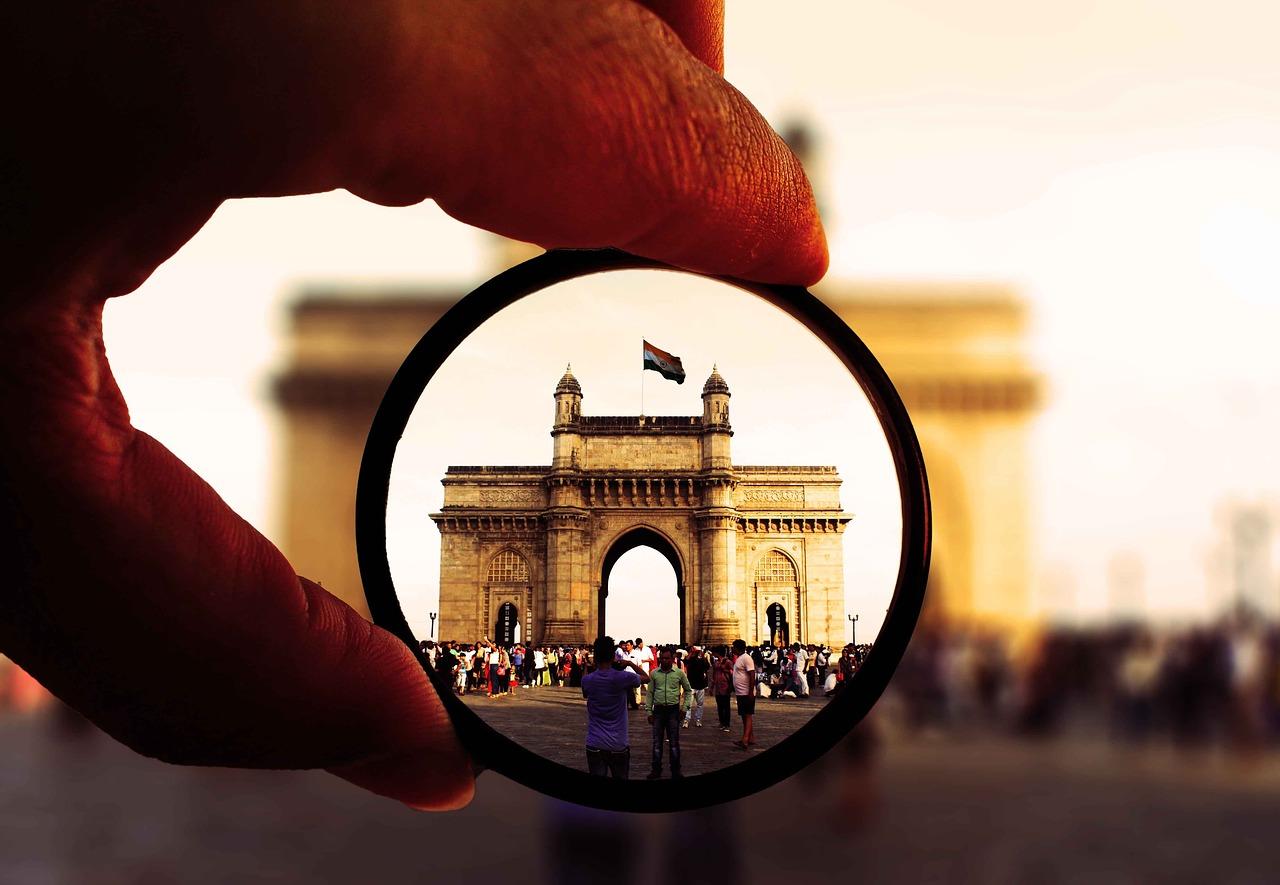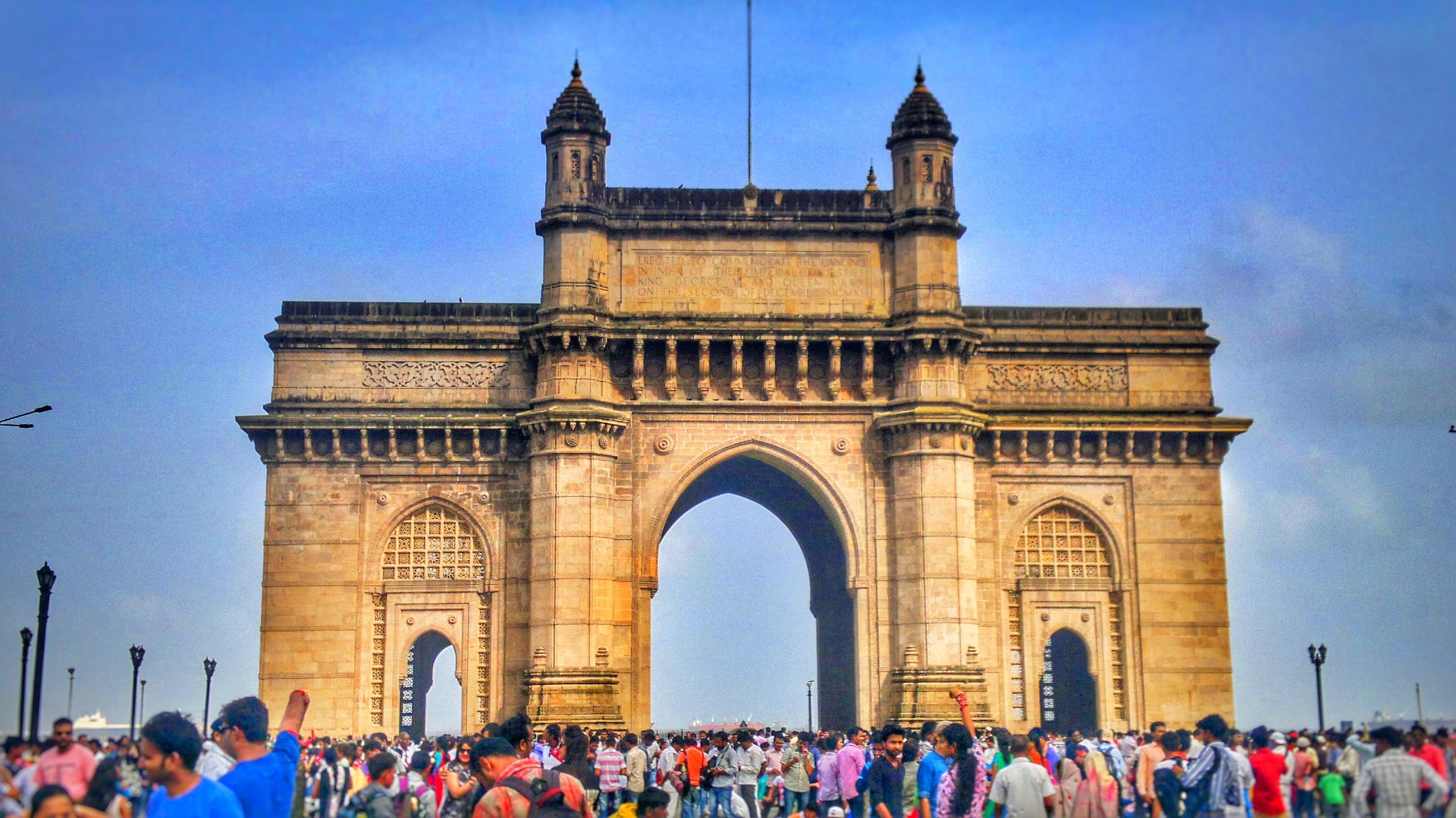Located in Mumbai (formerly, Bombay), India, the Gateway of India is an arch landmark that dates back to the 20th century. The monument was built to honour King George V and Queen Mary's 1911 visit to Apollo Bunder during their tour of India.
The Gateway of India was constructed in the Indo-Saracenic style of architecture, and its foundation stone was laid on March 31, 1911. The construction is a 26-meter-high (85-foot) basalt arch. George Wittet's final design was approved in 1914, and the monument's construction was completed in 1924. Later, the Gateway served as the new ceremonial entrance for the Governors of Bombay and the Viceroys of India.
Overlooking the Arabian Sea, the Gateway of India is situated on the waterfront in South Mumbai's Apollo Bunder neighbourhood at the end of Chhatrapati Shivaji Marg. Known as the Taj Mahal of Mumbai, the monument is the most popular tourist destination in the city, with Gateway of India photos gracing the walls of nearly every travel agency in the vicinity, indeed the state.
Discover the romantic history of the Taj Mahal.

History of Gateway of India

Currently a popular tourist destination, the Gateway of India draws food sellers, souvenir shops, and photographers. The first recorded major event at the Gateway of India was the passing of the 'First Battalion of the Somerset Light Infantry'. On February 28, 1948, the final group of British troops and divisions left India following India's independence.
In celebration of King George V and Queen Mary's official declaration as Emperor and Empress of India at the Delhi Durbar in December 1911, the Gateway of India was constructed. On March 31, 1911, the Governor of Bombay, Sir George Sydenham Clarke, placed the foundation stone for the monument at what was then a makeshift dock used by the local fishing population. The planned edifice was shown to the royal guests in the form of a cardboard model, and on March 31, 1914, Scottish architect George Wittet's final design was approved.
In 1915, the first steps were taken to reclaim ground at the Apollo Bunder (English: port) in order to create the Gateway and a new sea wall. The actual construction began in 1919 after the land reclamation process was completed, and it was finished in 1924. On December 4, 1924, the Viceroy of India, Rufus Isaacs, Earl of Reading, officially opened the Gateway of India. Due to financial constraints, the approach road to the Gateway was never constructed.
Learn the fascinating history of Charminar, Hyderabad's crowning jewel.
Structure, Architecture, and Design
Scottish architect George Wittet created the design for the Gateway of India, and Gammon India Limited—the only building business in India at the time with an ISO 9001: 1994 recognized accreditation in every area of civil engineering—completed the construction work. Yellow basalt stones interwoven with reinforced concrete at the foundations were used to build the edifice. Local suppliers provided the stone. The screens with holes were transported from Gwalior. At the end of Apollo Bunder, the building faces Mumbai Harbor and forms an angle with the road leading to it.
Built mostly in the Indo-Saracenic architectural style with certain Muslim components integrated, the edifice is essentially a Triumphal Arch. During their time in India, the British brought this architectural style to the country. It blends various aspects of Hindu and Muslim architecture with Gothic cusped arches, domes, spires, tracery, minarets, and stained glass in a unique way.
There are three parts to the rectangle construction. The structure's primary arches rise to a height of 85 feet. A dome of 48 feet in diameter and 83 feet in height is located inside the central block. Large halls with arches that are covered in finely carved stone screens and have a capacity of 600 people each are located on either side of the arch. The centerpiece of the Gateway of India's construction, the central dome is connected by four turrets and adorned with elaborate latticework.
The Arabian Sea is easily accessible via steps that emerge from below the Gateway's arch. An amazing vista of the Arabian Sea filled with both opulent ships and fishing vessels is framed by the arch. When the sun sets, the building comes to life, offering a stunning vista that includes the Taj Mahal Palace hotel and tower just next door.
Travel to India's seat of political power and unravel the history of the Red Fort.
On January 26, 1961, a statue of Chhatrapati Shivaji was unveiled in front of the gateway as a representation of Maratha pride and glory. In honour of Swami Vivekananda's trip from Mumbai to Chicago for the Parliament of World Religions, there is also another statue of him nearby.

Historical Significance of the Gateway of India
The monument is significant to Indian history and represents the height of British colonial rule in India and their total domination over the country in all spheres of life. Ironically, this edifice served as the final point of the British Empire's dominance in India, when the last British troops left the country following independence. More recently, Rabbi Holtzberg lost his life in the attack on Nariman House, therefore the monument has taken on a special meaning for Jews in the wake of the horrific 26/11 terror attacks on the city in 2008.
Gateway of India Tourist Information
Today, the Gateway of India is more of a tourist destination than a reminder of India's colonial past. It draws tens of thousands of visitors from within India as well as overseas who congregate to enjoy the historical significance and cultural attractions of the popular tourist spot. It is a very striking architecture that will undoubtedly catch your attention if you walk by, and it does a fantastic job of placing things in scale and perspective. The history behind it is, to put it mildly, intriguing.
Discover the towering glory that is the Qutab Minar through a historical lens.
Nearby Places to Explore
Colaba Causeway: The best market in Mumbai for enjoying street shopping is Colaba Causeway Market. Clothes are available at extremely inexpensive prices. There are numerous chic shops and historic British structures that provide guests with the ideal vista.
Walkeshwar Temple: Legend has it that Lord Ram once came to this temple with his arrows and the sea. It is a prominent Hindu shrine. According to scholars, the temple is older than three millennia.
Nehru Science Centre: Art exhibitions, science exhibits, and a few foreign events are held here. This site is perfect for you if you have an inner scientist.
The monument is open to visitors at all hours of the day. November through March is the ideal time of year to visit the Gateway of India because of the lovely post-monsoon weather and the low likelihood of rain during this season.
Revel in the history of the Ajanta Caves and celebrate India's cultural diversity.
The enormous expanse of the Arabian Sea is visible from the Gateway of India. Photographers and lovers of the outdoors appreciate this area. If you have an intense interest in photography, take a day off from your busy schedule to visit and frame some memorable Gateway of India photos first thing in the morning. You will have lots of opportunities to photograph the stunning changes in the sky and the glistening waves of the sea from dawn till dusk.
One may notice a statue of Maratha King Shivaji directly across from the monument. In 1961, a statue was erected in Shivaji's honour to commemorate his valiant 17th-century guerilla battle against the British. Another statue of Swami Vivekananda is located there. Near the monument, there is a yacht club and a commercial jetty from which you can catch jetty rides to the Elephanta Caves which can be reached in fifty minutes.
Marvel at India's architectural glory through a history of the Ellora Caves.

The Elephanta Festival, which takes place here in February for two days close to the Gateway of India, is another highlight. Due to an influx of tourists, the celebration, which was previously hosted in the Elephanta caves, has been moved to the area surrounding the Gateway of India. The "Annual Festival of Sails Regatta," which consists of multiple sailboat races held at various times throughout the day, is one event that is hosted every year at the Gateway of India.
Travel back in time to the majestic Konark Sun Temple in Odisha.
Sailing at the Gateway of India
Sail across the calm waters of the Arabian Sea when the gentle winds caress your face and the sky is lit up by the sun. You'll feel like you're drifting off because of the serene seas and whimsical skies. Sailing on beautiful turquoise flowing waters is going to supply you with all you need and take you on a new high, whether you are a tourist or just a Mumbaikar looking for a break from your everyday life or someone who is desiring some alone, quality time with your loved one.
Trace India's spiritual roots with a history of the Khajuraho temples.
Daily sailing slots are available from 7 a.m. to 8 p.m. for a duration of 2 hours, which includes a 30-minute journey from the shore to the boat and back. Weekend rates differ from those of the weekdays. Either reserve the entire yacht or pay for each individual and go on a trip with them. There are various boat and yacht categories with varying amenities. On request, some service providers can provide additional services like elaborate décor and catering for events like birthdays, anniversaries, proposals, and so forth. Over the years, early evenings have proven to be the most popular time for tourists. As the sun sets and the weather turns pleasant, it's the ideal time. Usually, the last ferry leaves at 5:00 p.m.
Need help with your geography class? Enlist a tutor on Superprof today!















